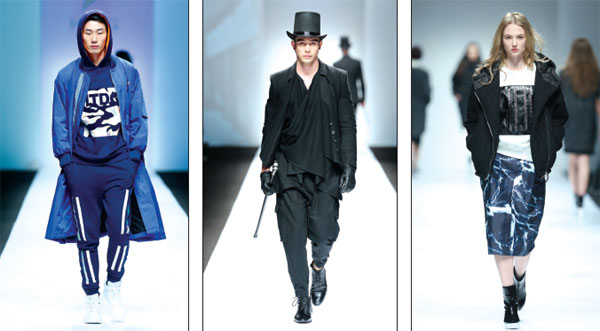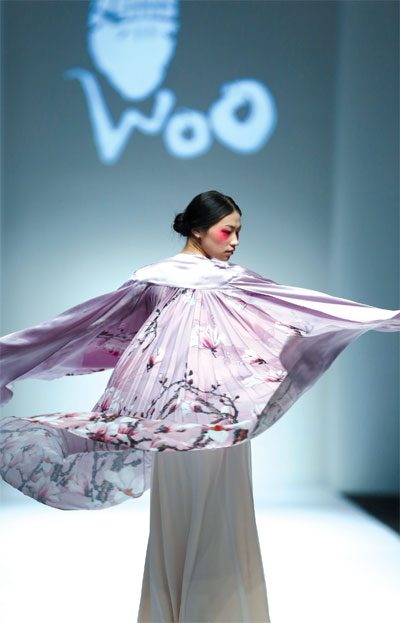City starting to close gap with world fashion capitals
Updated: 2015-04-24 11:25
By Xu Junqian in Shanghai(China Daily USA)
|
||||||||
Shanghai Fashion Week introduces a showroom for business deals and focuses more on homegrown talent as it takes tips from biggest markets
There was a small but important difference at this year's Shanghai Fashion Week: for the first time, it had an official showroom where deals potentially worth millions of dollars could be struck.
The bold gesture also highlights the grand ambitions of this government-sponsored event as it strives to close ranks with the big four fashion weeks in London, Paris, Milan and New York.
"A fashion week without a showroom would just be a series of shows held for their own sake," said Du Wenxia, one of the organizers. "A showroom provides a platform for real business to take place between buyers and designers."
The 5,000-square-meter showroom was located in an underground parking lot about 3 kilometers from Xintiandi, a downtown cluster of upscale bars and restaurants near a green park where about 50 fashion shows took place in a white tent from April 8 to 15.
Du said he is pinning great hopes on the showroom to bring Shanghai Fashion Week, now in its 13th year, "a step closer to the international level".
Like his colleagues at the Shanghai International Fashion Center, a subsidiary of state-owned Shangtex Group, which organizes the twice-yearly event, he sees it as a greenhouse where China's own Michael Kors or Tommy Hilfiger may be cultivated.
Founded in 2003, Shanghai Fashion Week was initially blasted as a public relations exercise that squandered vast sums of money in a bid to promote China's fashion industry, with international luxury brands lured as a face-saving measure.
But the doubting Thomases misread the city's ambition, which from the outset was to transform Shanghai into the world's fifth fashion capital.
In the first year alone, Lanvin and Vivienne Westwood brought their collections and made a big splash.
Recently, as competition ramps up and China shows signs of ending its infatuation with foreign luxury brands in favor of less ostentatious homegrown products, the focus has been shifting back to domestic designers.
According to statistics from Style.com, over 80 fashion weeks are now held each year around the world.
Despite the presence of big names in Shanghai this month like Diesel founder Renzo Rosso and artistic director Nicola Formichetti, young local designers accounted for over half of the shows held.
"I see world-class creativity here," said Imran Amed, the editor-in-chief of London-based Businessoffashion.com.
Amed attends around 25 fashion weeks a year and said he is "more interested in the less glamorous and more business side of the industry".
As his website launched a Chinese-language version late last year, Amed visited Shanghai Fashion Week for the first time to engage more closely with what he called the world's fastest-developing market.
"The most exciting thing here is the young designers. If China is going to have an international fashion capital, they must be the ones making it possible," he said.
He said they lack support at the moment and that China is still missing a healthy fashion industry ecosystem.
The showroom, which was open for three days, might help plug some of the gaps. Called Mode Shanghai, it welcomed over 200 fashion brands and independent designers. It saw Chinese fashion buyers feel fabrics and talk to designers while also offering a free platform for less-established designers and brands to mingle.
In contrast, the cost of a fashion show at the event ran from 60,000 to 100,000 yuan ($9,670-16,110).
Some 1,500 people registered an appointment at the showroom, up to 80 percent of whom were professional buyers and industry insiders, the organizers said.
"It saw many more visitors than its counterparts at shows in Europe," said Guo Yirantian, a 24-year-old designer who attended the latest fashion weeks in Paris and London.
There could be anywhere between 300 and 1,000 fashion buyers' stores in China. Real-estate consultancy RET Property claims there are 300, with Shanghai topping the list at 69, followed by Beijing and Chengdu of Sichuan province. Yang Jiong, co-founder of Showroom Shanghai, estimates there are over 1,000.
"Every designer aspires to become Valentino and every buyers' store wants to be Lane Crawford," said Lin Jian, a fashion commentator based in Shanghai. "A showroom is the bridge that connects the two parties and makes things possible."
Lane Crawford is one of Asia's top luxury department stores, with a focus on the buyers' culture.
M.A.C Cosmetics China replaced Maybelline as the official make-up partner of Shanghai Fashion Week for the first time this year. The company is headquartered in New York.
"Many Chinese designers are still in the phase of growth, expansion, exploration and event transformation rather than being fully settled or established," said Mark Jiang, M.A.C's general manager. "It means there is a lot of energy floating about."
Some designers create their own fabrics, some work magic with knitting yarns and others combine street and more upscale styles in inventive ways, he said.
According to the Wall Street Journal, M.A.C has "an uncanny knack for predicting what or who will be hot next." The brand supports 850 shows at 34 fashion weeks in 29 cities each year, including the big four.
xujunqian@chinadaily.com.cn
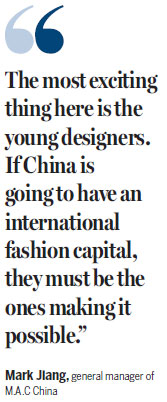
|
Fashion models present the works of local designers at the 2015 Fall Winter Shanghai Fashion Week. Lu Kun, Ban Xiaoxue and Guo Yirantian were among the top Chinese designers to have their clothes showcased. Photos Provided to China Daily |
|
Using silk scarves as his canvas, Sun Qingfeng, the Shanghai designer who founded Woo, introduced a collection inspired by Chinese ink paintings. |
(China Daily USA 04/24/2015 page8)
- Are you prepared to welcome the second royal baby?
- Spain recalls Venezuelan ambassador over Maduro conspiracy comments
- Anniversary of Armenian massacre marked
- DPRK to establish 2nd intl tourist zone
- Parade rehearsal held for Victory over Fascism in Russia
- Kim likely to visit Russia in May for war victory ceremony
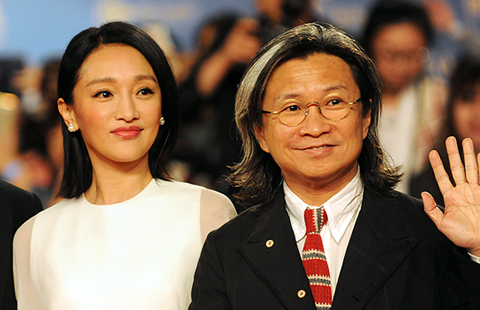
 5th Beijing International Film Festival closes
5th Beijing International Film Festival closes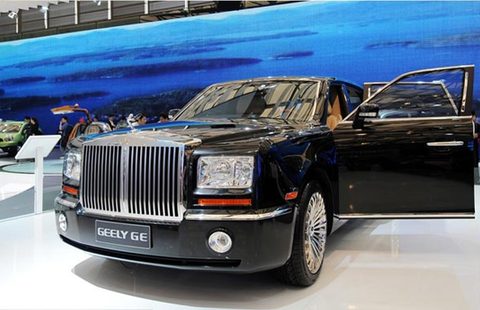
 Top 10 auto lookalikes in China
Top 10 auto lookalikes in China
 Flights cancelled as ash cloud pours from Chile volcano
Flights cancelled as ash cloud pours from Chile volcano
 Unusual but true: Kung fu girl stuns TV show judges
Unusual but true: Kung fu girl stuns TV show judges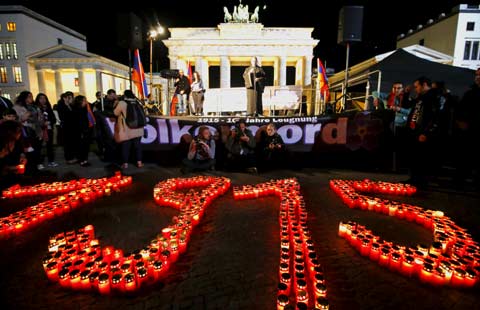
 100th anniversary of Armenian massacre marked worldwide
100th anniversary of Armenian massacre marked worldwide Volcano erupts in southern Chile, belching ash, smoke into sky
Volcano erupts in southern Chile, belching ash, smoke into sky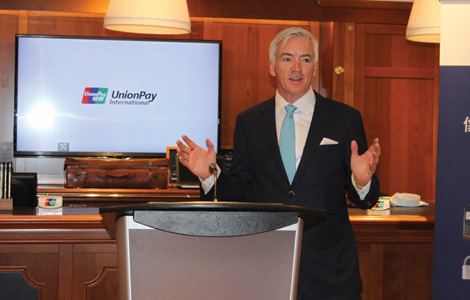
 Across Canada (April 24)
Across Canada (April 24)
 Ten photos you don't wanna miss - April 23
Ten photos you don't wanna miss - April 23
Most Viewed
Editor's Picks

|

|

|

|

|

|
Today's Top News
The real Apple Watchon sale Friday in China
China looks to top the bill in Hollywood productions
National Zoo panda to get semen from China
Chinese mourn passing of US officer
Sino-US nuclear cooperation proposal lauded
Furious 7 on track to be tops in China
As PayPal split looms, eBay plans to think small
China coal use to get cleaner
US Weekly

|

|
